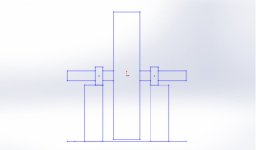Here's an idea. Disassemble the side cover from the rotor. It should be a tight fit. You should need to install the bolts in order to pull it together. if it has a loose fit, it's no good. Do a careful visual inspection on the lip on the outside flange of the side cover. Look for signs of cracks or deformation, like if it has shifted one way or another. Any problems here, the side cover needs replacement.
If you want to check, here is a procedure for sweeping the side cover.
1) Take the side cover off the rotor. There is no way this will work with all those magnets near the indicator.
2) Mount the side cover to the machine table with the inside facing up. This is harder than it sounds, because you can't obstruct the bores. I would suggest removing the freewheel adapter as I mentioned, then use the open bolt holes to attach the side cover to the table. The flange face needs to be pretty square to the table.
3) Put your test indicator in the spindle. sweep the bearing bore, moving the table around until there is virtually no run-out. The reading you get when no table movement will improve the centering is how out-of-round your bore is. Once you get here, lock the table.
4) Raise the spindle, then sweep the indicator around the male lip on the flange that presses into the rotor. You can switch the indicator if you need to, doesn't matter. Just don't move the table.
The Total Indicated Run-out (TIR) (high to low) is what is read off the indicator at this point. One half of the total is how far off center the bore is from the rotor locating lip. Take readings at 12:00, 3:00, 6:00 and 9:00
Simplified example:
12:00 +0.005" 3:00 +0.003"
6:00 -0.005" 9:00 -0.003"
This means the lip is .005 off center (0.010 TIR) at 12:00, .003" (.006 TIR) off center at 3:00, and .002 out of round ( .005 -.003)
You can check the axle if you have a lathe or bench centers, but it takes some experience and some setup that is difficult to explain. If you can press the axle out, you could take it to a shop, and they could check it for you in about 10 minutes. Or, you could send it to Tench. I know he would be interested, and if it's jacked he could make you a new, high strength version.
All that new info regarding your bike and riding style is important.
Since the magnets are hitting all the way around, either the bearing is trash, the axle is bent, or both. If the side cover bore is off center, the magnets would more likely hit only partway around. The side cover could still be damaged or out of spec.
I would encourage you to fix the motor. It's a really good motor, and I can't think of a stronger, lighter more durable substitute. Fix your suspension, and maybe rethink your riding habits. The stress created when the springs no longer do their job can become enormous. At least you still have the bump rubber, otherwise you would have probably blown out your shock by now.




